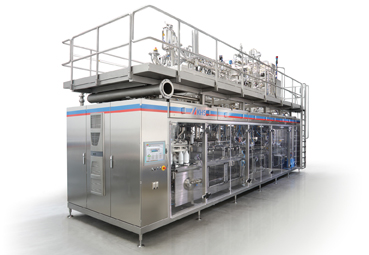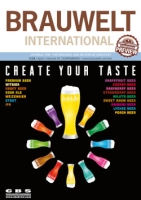Linear aseptic filling
With its Innosept Asbofill ABF 611 and Innosept Asbofill ABF 711, KHS launches a new generation of aseptic linear fillers for up to 12,000 plastic bottles per hour. While the standard model, the Innosept Asbofill ABF 611 fills 0.1 to 0.75-liter plastic bottles, the Innosept Asbofill ABF 711 is designed to fill 0.25 to 2.1-liter plastic bottles.
Both models are focused on filling non-carbonated beverages like milk, yogurt drinks, fruit juices, or fruit juice drinks. Integrated neck handling ensures processing of specially shaped rectangular and square bottles, for instance. One machine is able to fill either PET or HDPE bottles without conversion. During the dry sterilization process the surfaces of plastic bottles and closures are sprayed with H2O2 aerosol, then dried using hot air after reaction time. This ensures microbiological integrity regardless of the size and shape of the processed bottles.
For the Innosept Asbofill ABF 711 with 1.5 cubic meters or about 53 cubic feet (Asbofill ABF 611: 0.9 cubic meters or about 32 cubic feet) a very small sterile area is required. The plastic bottles are conveyed through all the processing stages in just one holder. Critical mechanical transfers, especially in the sterile zone, are avoided. The filling process works by means of two-stage free-flow filling valves, so that the plastic bottles will never get in contact with the filling valves. Volumetric filling of the plastic bottles by means of magnetic inductive flow metering ensures exact fill levels. Integrating pulp jets into the filling valves or flushing the bottles with nitrogen before and after the filling process are possible options. Another possible option is placing a drop of liquid nitrogen in the head space of filled plastic bottles. This method additionally prevents the negative influence of oxidation and enhances the stability of particularly lightweight bottles resulting in less consumption of PET-material.
Double-filter units in place of single-filter units in the grouped valves and coding the bottles during the production process can also be integrated into the machines later. Bottle sealing can be done via aluminum seals (fully automated infeed) and plastic screw-on caps. The pressing and fusing of the seal are carried out simultaneously. For plastic screw-on caps or sport caps, placing the caps and screwing them is taking place in separate sterile chambers. There is no rotary capping motion in the aseptic zone.
A twin concept allows to increase the filling capacity up to 24,000 bottles an hour. Hence, the investment in two individual machines is offset by a clear reduction not only in cost, but also in the amount of space required.
Source
BRAUWELT International 2011


